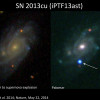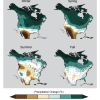News
Multidimensional Image Processing and Analysis in R
An esoteric, open-source programming language—called R—could pave the way for open science. Thousands of scientists are participating in the R development community, including CRD's Talita Perciano. As a student, she contributed one of the first image-processing tools—called R Image Processing Analysis (RIPA)—to the community. Now with big science datasets in mind, she’s updated the existing tool with improved features for complex data analysis. Read More »
Confirmed: Stellar Behemoth Self-Destructs in Type IIb Supernova
For the first time ever, astronomers have direct confirmation that a Wolf-Rayet star—sitting 360 million light years away in the Bootes constellation—died in a violent explosion known as a Type IIb supernova. Using the iPTF pipeline, researchers caught supernova SN 2013cu within hours of its explosion. These observations are providing valuable insights into the life and death of the progenitor Wolf-Rayet. These stars are interesting because they enrich galaxies with the heavy chemical elements that eventually become the building blocks for planets and life. Read More »
Berkeley Lab Climate Scientist: More Extreme Heat and Drought in Coming Decades
By the end of this century climate change will result in more frequent and more extreme heat, more drought, and fewer extremes in cold weather in the United States. Average high temperatures could climb as much as 10 or more degrees Fahrenheit in some parts of the country. These are some of the projections made by Berkeley Lab climate scientist Michael Wehner and his co-authors on the National Climate Assessment (NCA). Read More »
New Employee Profiles
Introducing: Rachel Hollowgrass, Hamdy Elgammal, Meiyue Shao and Ray Spence Read More »
Atomic Swtcheroo Explains Origins of aThin-film Solar Cell Mystery
Scientists have known since the 1980s that treating cadmium-telluride (CdTe) solar cell materials with cadmium-chloride improves efficiency, but the underlying physics has remained a mystery until now. Combining electron microscopy with computer simulations run at the Department of Energy’s National Energy Research Scientific Computing Center (NERSC), researchers have put this decades long debate to rest. Read More »
NERSC, Cray, Intel to Collaborate on Next-Generation Supercomputer
Scheduled for delivery in mid-2016, the new Cray XC system will deliver 10x the sustained computing capability of NERSC’s Hopper system, further enhancing scientific discovery at the Department of Energy's Office of Science. Read More »
Calming Plasma's Stormy Seas
Simulations run on NERSC's Edison system show how overcoming ion instabilities in hot plasma can boost a tokamak reactor’s energy output. Read More »
Berkeley Lab Scientists Host 12 Albany Students for Annual Job Shadow Day
For the sixth consecutive year, researchers across Berkeley Lab hosted 12 juniors from Albany High School in conjunction with the school’s annual Job Shadow Day. In advance of the event, students select areas of career interest and parent volunteers match them with mentors around the Bay Area. Read More »
Clocking the Early Universe
Astronomers have made the most accurate calculation yet of the expansion rate of the young Universe with help from supercomputers at NERSC. Their findings could help uncover the nature of dark energy, the mysterious, repulsive force that pervades our universe causing it to expand at an accelerating rate. Read More »
To Bridge LEDs’ Green Gap, Scientists Think Small…Really Small
Nanostructures half the breadth of a DNA strand could improve the efficiency of light emitting diodes (LEDs), especially in the “green gap,” a portion of the spectrum where LED efficiency plunges, simulations at the U.S. Department of Energy’s National Energy Research Scientific Computing Center (NERSC) have shown. Read More »







 Instagram
Instagram YouTube
YouTube






